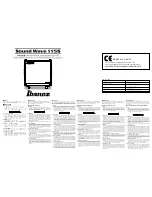
9
SYSTEM INSTALLATION
There will most likely be a number of cables involved in the installation of your home entertainment system.
Preplanning is essential in order to maximize system efficiency. We recommend the following as a means of
helping you reach that goal.
Make a diagram of your proposed system by laying out the relative location of each component in the
system. Then lay out the proposed cable runs between them. Number each cable and record its length on
the diagram for future use.
Cable runs are critical in that they must be kept away from the sources of power radiation (amplifiers,
power cords, heaters, appliances, etc.). For safety reasons, they should also be kept out of traffic areas.
The process of optimizing the system will include the type of cable, the length of the run, and the
obstructions it must deal with along its run. Your dealer can advise you on the products available and
their relative merits. If building custom length audio cable is not your strength, you dealer should be able
to help you with that as well.
When possible, use a separate AC power line for the amplifier, one that is not shared by any other
household component.
THIS IS VERY IMPORTANT!!!
Tip
: Take a piece of string (longer than the longest cable run) and mark it at each foot of length. Then do a mock
cable run using the string, dressing it neatly along the way. Count the divisions to the next full foot, and add one
foot to all for some movement of the components. This will provide you with ideal cable length.
MAKING THE CONNECTION
Before doing anything, insure that the power switch on the amplifier’s front panel is in the ‘off’ position.
Again, it is recommended that you locate a separate AC power outlet for the amplifier, one that is
not
shared
by any other audio component in the system or any other household component. This will eliminate the
possibility of the amplifier ‘modulating’ the power being supplied to the component and compromising the
signal originating from that component.
Locate the AC power cord provided with the amplifier and plug it into the power input receptacle in the rear
panel.
Do not connect it to the AC power source yet!
Connect the audio cable from your preamplifier’s output to the corresponding input connector on the amplifier.
Connect the wire from your speakers to the appropriate outputs on the amplifier. It is absolutely essential that
you observe correct polarity in all theses connections.
Example:
If you connect your left output of your preamplifier to channel 4 input on the amplifier, remember to
connect your left speaker wires to channel 4’s outputs. Always observe polarity when connecting speakers,
connect amplifiers (+) to the speakers (+) and amplifiers (-) to speakers (-).
Double-check all connections.
Connect a playback unit (CD, DVD, VLD, Tuner, etc.) to the preamplifier. Turn on the preamplifier, turn the
volume on the preamplifier to a minimum level, and then turn on the amplifier (in that order). Set the source
on the preamplifier to the playback unit you’ve just connected. Turn the volume up slowly and listen for music
from all channels. If this is not the case, and you don’t hear any sound, double-check your installation.
Should you encounter any problem that cannot be traced to the source or the material being played, consult
the “TROUBLESHOOTING” section on page 10.
Note: When turning equipment ‘off’, the amplifier should always be turned off
first
, then the preamplifier.
Before
turning anything on, insure the preamplifier is at a low volume level.


































